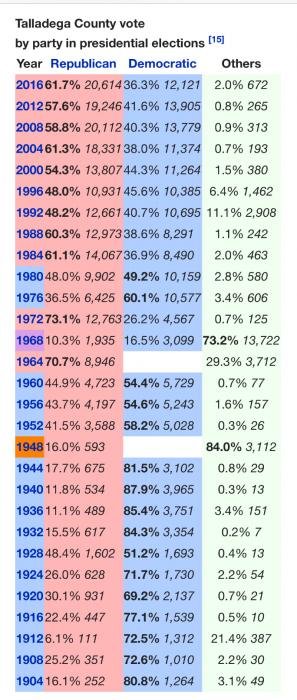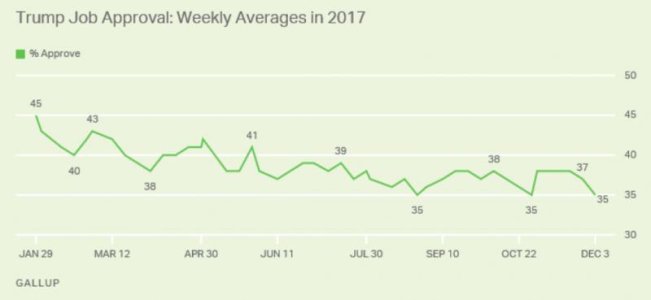CoolBlue71
JUB Addict
The Midterm Elections of 2018
One year from today, which will be [Tuesday,] November 6, [2018], are the midterm elections of 2018.
A new report is here: “Post-ABC poll: Voters favor Democrats over Republicans in 2018 House midterms by widest margin in years” (By Sean Sullivan and Emily Guskin | November 6, 2017 | http://www.washingtonpost.com/power...e2b598d8c00_story.html?utm_term=.074b49dec011 ). It relates to this thread topic.
The job-approval percentage ratings for Republican U.S. president Donald Trump have been typically in the 30s. That is pretty much at the level where his predecessor, Democrat Barack Obama, was eight years ago at this time, and one year from a coming, scheduled midterm elections cycle.
All 435 U.S. House seats are on the schedule for 2018. Approximately one-third the U.S. Senate seats are also on the ballot. And 36 of the nation’s 50 states will hold gubernatorial elections. From that 36, nine of the Top 10 populous states are on the schedule: California, Texas, Florida, New York, Illinois, Pennsylvania, Ohio, Georgia, and Michigan. (The state of North Carolina holds its gubernatorial elections with presidential elections.)
What may play out with the midterm elections of 2018 may remain pretty faithful with established, historical voting pattern. The party which tends to win overall seat gains is the White House opposition party; that this would be applicable, in 2018, to the Democratic Party.
Since 1914, following the 17th Amendment (giving direct elections of U.S. senators to the states’ voters), there have been 26 midterm elections (1914 to 2014). From this number, there were just three which resulted in overall seat gains won by the White House party. (They occurred in 1934, 1998, and 2002.)
I took a look at the Bush and Obama presidencies—Elections 2000, 2004, 2008, and 2012—and compared the participating votes for U.S. House in those presidential elections to their following midterm elections cycle (2002, 2006, 2010, and 2014).
The reason I compared the U.S. House is that 100 percent of the 435 congressional districts are on the schedule in both midterm and presidential election cycles. (To compare the U.S. Senate is not appropriate. There are approximately one-third of that 100-member body scheduled for elections every two years.)
From 2000 to 2014, and according to these numbers from Wikipedia, here were the participating votes—specifically for U.S. House—in presidential vs. midterm elections:
The midterm elections of 2002 resulted in Republicans having won a pickup of the U.S. Senate. But, usually the flip is to the opposition party. Jim Jeffords, in mid-2001, made the switch from Republican to independent and to caucus with the Democrats. This flipped majority control to the Democrats. 2002 went against historical voting pattern.
The midterm elections of 2006 resulted in Democratic pickups of both houses of Congress on the watch of Republican president George W. Bush.
The midterm elections of 2010 was a Republican pickup of the U.S. House on the watch of Democratic president Barack Obama. Six Democratic-held U.S. Senate seats flipped Republican, going from 59 down to 53 for the Democrats.
The midterm elections of 2014 resulted in a Republican pickup of the U.S. Senate on the watch of Democratic president Barack Obama.
If the 2018 midterm elections have, once again, a decline in participation similar to those listed examples, then it would be very possible—if the Democrats have more participants (as the Republicans did in 2010 and 2014), and the self-identified independent voters cast votes for Democrats (as they did, for the Republicans, in 2010 and 2014)—for at least one of the two houses of Congress to flip Democratic. When they don't flip in the same election cycle, the U.S. House tends to be the one which goes first.
Does this mean that Donald Trump will not get re-elected in 2020? No. You can look at the those presidents, starting with Woodrow Wilson (1912, 1916), and with the last applicable being Barack Obama (2008, 2012), who won two terms. Nearly all of them saw same-party majority control either flip or lose notable or significant numbers in the U.S. House and/or U.S. Senate with their second year in office. This was true of Wilson (1914), Dwight Eisenhower (opposition-party pickups of both houses of Congress, 1954), Richard Nixon (1970), Ronald Reagan (1982), Bill Clinton (opposition-party pickups of both houses of Congress, 1994), and Barack Obama (opposition-party pickup of the U.S. House, 2010). Two years after those midterm losses saw re-elections for Wilson (1916), Eisenhower (1956), Nixon (1972), Reagan (1984), Clinton (1996), and Obama (2012).
What I think, at this point, is this:
The midterm elections of 2018 will be overall seat gains for the Democrats. And they may flip the U.S. House. In fact, I am kind of leaning toward predicting a Democratic pickup of the U.S. House. (One would need to track the polls to get a good idea of the trajectory of that happening. It may be necessary to actually get into the year 2018.) The U.S. Senate is trickier because of the specific states on the schedule.
How would the Democrats win overall seat gains? Looking at the above list of presidential-vs.-midterm U.S. House votes, and decline in participation in midterms, it would be more overall participation from self-identified Democrats than self-identified Republicans. This would be followed by self-identified independents ending up giving more votes for Democratic than Republican candidates. Crunch whatever all those numbers would be, and that creates a strong trajectory that could turn out to be a wave—a potential, national midterm wave election for the Democratic Party.
One year from today, which will be [Tuesday,] November 6, [2018], are the midterm elections of 2018.
A new report is here: “Post-ABC poll: Voters favor Democrats over Republicans in 2018 House midterms by widest margin in years” (By Sean Sullivan and Emily Guskin | November 6, 2017 | http://www.washingtonpost.com/power...e2b598d8c00_story.html?utm_term=.074b49dec011 ). It relates to this thread topic.
The job-approval percentage ratings for Republican U.S. president Donald Trump have been typically in the 30s. That is pretty much at the level where his predecessor, Democrat Barack Obama, was eight years ago at this time, and one year from a coming, scheduled midterm elections cycle.
All 435 U.S. House seats are on the schedule for 2018. Approximately one-third the U.S. Senate seats are also on the ballot. And 36 of the nation’s 50 states will hold gubernatorial elections. From that 36, nine of the Top 10 populous states are on the schedule: California, Texas, Florida, New York, Illinois, Pennsylvania, Ohio, Georgia, and Michigan. (The state of North Carolina holds its gubernatorial elections with presidential elections.)
What may play out with the midterm elections of 2018 may remain pretty faithful with established, historical voting pattern. The party which tends to win overall seat gains is the White House opposition party; that this would be applicable, in 2018, to the Democratic Party.
Since 1914, following the 17th Amendment (giving direct elections of U.S. senators to the states’ voters), there have been 26 midterm elections (1914 to 2014). From this number, there were just three which resulted in overall seat gains won by the White House party. (They occurred in 1934, 1998, and 2002.)
I took a look at the Bush and Obama presidencies—Elections 2000, 2004, 2008, and 2012—and compared the participating votes for U.S. House in those presidential elections to their following midterm elections cycle (2002, 2006, 2010, and 2014).
The reason I compared the U.S. House is that 100 percent of the 435 congressional districts are on the schedule in both midterm and presidential election cycles. (To compare the U.S. Senate is not appropriate. There are approximately one-third of that 100-member body scheduled for elections every two years.)
From 2000 to 2014, and according to these numbers from Wikipedia, here were the participating votes—specifically for U.S. House—in presidential vs. midterm elections:
• 2000: 98,799,963 | 2002: 74,706,555 (75.61%; –24.39%)
• 2004: 113,192,286 | 2006: 80,975,537 (71.53%; –28.47%)
• 2008: 122,486,293 | 2010: 86,784,957 (70.79%; –29.21%)
• 2012: 122,346,020 | 2014: 78,235,240 (63.94%; –36.06%)
• 2004: 113,192,286 | 2006: 80,975,537 (71.53%; –28.47%)
• 2008: 122,486,293 | 2010: 86,784,957 (70.79%; –29.21%)
• 2012: 122,346,020 | 2014: 78,235,240 (63.94%; –36.06%)
—Totals—
• Presidential: 456,924,562 | Midterm: 320,702,089 (70.18%; –29.82%)
The midterm elections of 2002 resulted in Republicans having won a pickup of the U.S. Senate. But, usually the flip is to the opposition party. Jim Jeffords, in mid-2001, made the switch from Republican to independent and to caucus with the Democrats. This flipped majority control to the Democrats. 2002 went against historical voting pattern.
The midterm elections of 2006 resulted in Democratic pickups of both houses of Congress on the watch of Republican president George W. Bush.
The midterm elections of 2010 was a Republican pickup of the U.S. House on the watch of Democratic president Barack Obama. Six Democratic-held U.S. Senate seats flipped Republican, going from 59 down to 53 for the Democrats.
The midterm elections of 2014 resulted in a Republican pickup of the U.S. Senate on the watch of Democratic president Barack Obama.
If the 2018 midterm elections have, once again, a decline in participation similar to those listed examples, then it would be very possible—if the Democrats have more participants (as the Republicans did in 2010 and 2014), and the self-identified independent voters cast votes for Democrats (as they did, for the Republicans, in 2010 and 2014)—for at least one of the two houses of Congress to flip Democratic. When they don't flip in the same election cycle, the U.S. House tends to be the one which goes first.
Does this mean that Donald Trump will not get re-elected in 2020? No. You can look at the those presidents, starting with Woodrow Wilson (1912, 1916), and with the last applicable being Barack Obama (2008, 2012), who won two terms. Nearly all of them saw same-party majority control either flip or lose notable or significant numbers in the U.S. House and/or U.S. Senate with their second year in office. This was true of Wilson (1914), Dwight Eisenhower (opposition-party pickups of both houses of Congress, 1954), Richard Nixon (1970), Ronald Reagan (1982), Bill Clinton (opposition-party pickups of both houses of Congress, 1994), and Barack Obama (opposition-party pickup of the U.S. House, 2010). Two years after those midterm losses saw re-elections for Wilson (1916), Eisenhower (1956), Nixon (1972), Reagan (1984), Clinton (1996), and Obama (2012).
What I think, at this point, is this:
The midterm elections of 2018 will be overall seat gains for the Democrats. And they may flip the U.S. House. In fact, I am kind of leaning toward predicting a Democratic pickup of the U.S. House. (One would need to track the polls to get a good idea of the trajectory of that happening. It may be necessary to actually get into the year 2018.) The U.S. Senate is trickier because of the specific states on the schedule.
How would the Democrats win overall seat gains? Looking at the above list of presidential-vs.-midterm U.S. House votes, and decline in participation in midterms, it would be more overall participation from self-identified Democrats than self-identified Republicans. This would be followed by self-identified independents ending up giving more votes for Democratic than Republican candidates. Crunch whatever all those numbers would be, and that creates a strong trajectory that could turn out to be a wave—a potential, national midterm wave election for the Democratic Party.





















